Introduction
In recent years, the black kitchen sink has surged in popularity, becoming a standout feature in modern kitchen design. Once considered a daring choice, these sinks now anchor stylish kitchens with their bold, sophisticated appeal. Homeowners and designers alike are embracing black sinks not just for their visual impact but for their ability to elevate both minimalist and eclectic spaces. Whether you’re planning a full kitchen renovation or simply want to refresh your cooking area, a black kitchen sink offers a striking blend of form and function.
This guide is your go-to resource for everything about black kitchen sinks. We’ll walk you through material options, style configurations, and practical tips to help you decide if a black sink fits your lifestyle. You’ll also learn how to maintain its sleek look and pair it seamlessly with your kitchen’s decor.
Here’s a snapshot of what we’ll cover:
- Why black sinks are trending in modern homes.
- Material choices range from durable fireclay to scratch-resistant composite granite.
- Pros and cons to weigh before buying.
- Cleaning hacks to keep your sink flawless.
- Design ideas to inspire your kitchen makeover.
Black kitchen sinks aren’t just a passing trend; they’re a design-forward choice that combines practicality with undeniable style. Let’s dive into why these sinks are capturing so much attention and how they could transform your space.
The Allure: Why Choose a Black Kitchen Sink?
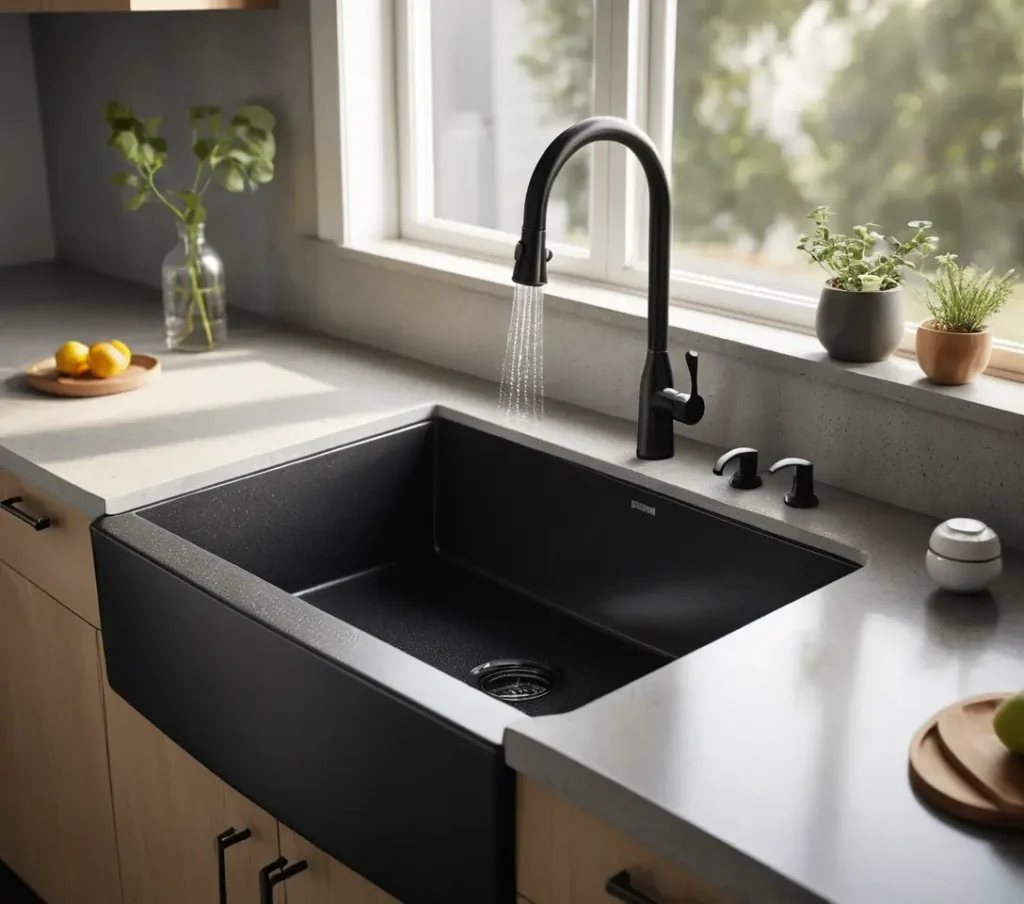
A black kitchen sink isn’t just a functional fixture; it’s a bold design element that transforms your kitchen’s aesthetic. Let’s explore why these sinks are winning over homeowners and designers.
Aesthetic Appeal: Contrast & Cohesion
Black sinks create a striking contrast, especially against light countertops like white quartz or marble. Imagine your countertop as a canvas; a black sink acts like a frame, drawing attention to its texture and color. This contrast adds depth, making your kitchen feel dynamic and intentional.
They also adapt effortlessly to different styles:
- Modern kitchens: Pair a matte black sink with sleek, handleless cabinets for a minimalist look.
- Farmhouse charm: An apron-front black sink becomes the rustic centerpiece of a cozy, wood-accented space.
- Industrial edge: Combine a black sink with exposed metal fixtures and concrete countertops for raw, urban vibes.
WE ALSO SHARE Gorgeous Black Bathroom Mirror Ideas You need to try now!
Perceived Practicality: Beyond the Surface
Many choose black sinks, thinking they’ll hide coffee splatters or wine spills better than white sinks. While this holds for some stains, black surfaces can highlight water spots or light-colored debris like flour. The key is balance. A black sink won’t erase messes, but it can reduce the urgency of wiping every drip. (We’ll dive deeper into maintenance in a later section.)
Versatility: Fits Any Kitchen Personality
Black sinks are chameleons in design. Here’s how they shine in popular styles:
- Contemporary: Glossy black sinks reflect light, amplifying a bright, airy kitchen.
- Transitional: Pair with brass faucets and warm wood tones for a balanced, inviting feel.
- Eclectic: Use a black sink to anchor a mix of bold colors and patterns without overwhelming the space.
A Note on Visual Impact
A black sink anchors your kitchen, creating a focal point that ties together hardware, lighting, and decor. It’s particularly effective in open-plan homes, where the kitchen flows into living areas. The sink’s dark hue defines the space, adding structure without closing it in.
Decoding Black Sink Materials: Finding the Right Fit
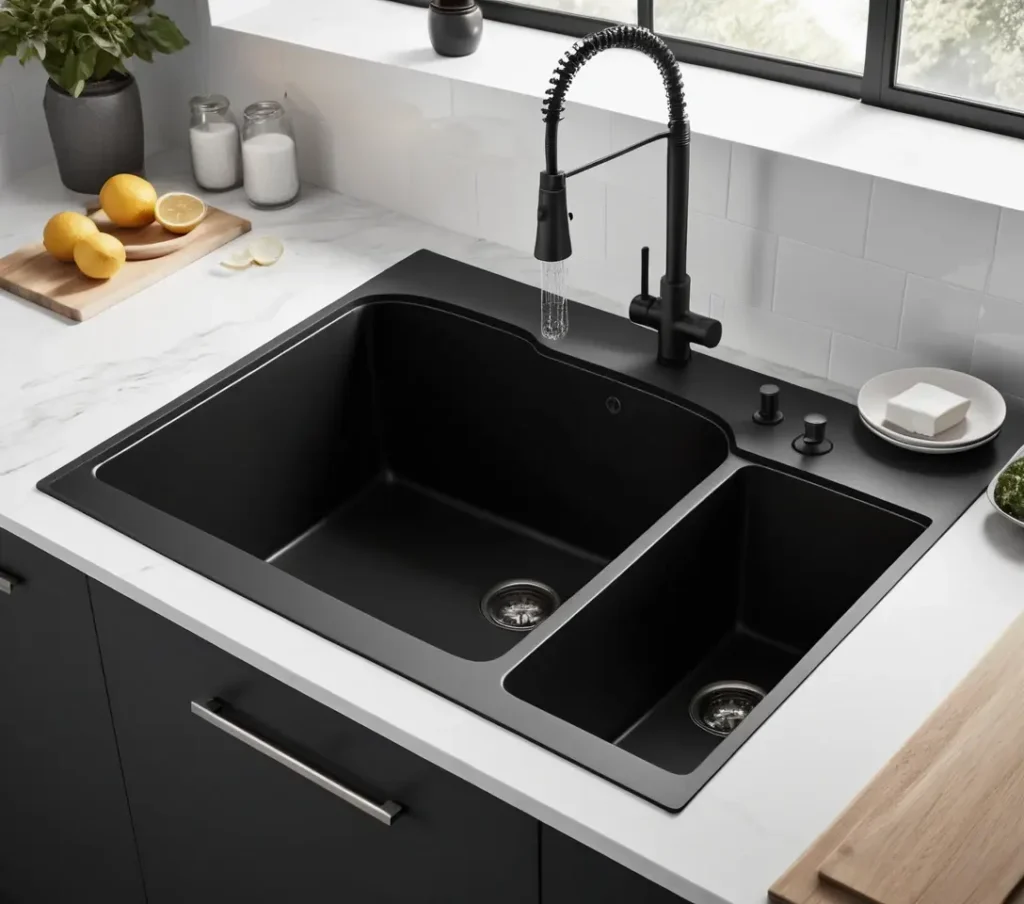
A black kitchen sink isn’t defined by a single material. Your choice affects durability, upkeep, and even how the color holds up over time. Let’s break down the most common options to help you pick the best fit for your kitchen.
Granite Composite & Quartz Composite Sinks
These sinks blend crushed stone (granite or quartz) with resin, creating a dense, stone-like surface. Brands like Blanco Silgranit and Franke Fragranite popularize this category.
Pros:
- Resists scratches, stains, and heat better than most materials.
- Color stays consistent over time, with a matte finish that hides minor wear.
- Lightweight compared to natural stone yet highly durable.
Cons:
- Heavy pots or pans dropped carelessly can cause cracks or chips.
- Avoid harsh scrubbers or acidic cleaners, which may dull the surface.
Quick Tip: Use mild dish soap and a soft cloth for daily cleaning. For tough stains, baking soda paste works wonders.
Black Stainless Steel Sinks (PVD/Nano Coating)
Stainless steel sinks get their black hue from advanced coatings like PVD (Physical Vapor Deposition) or nano coatings.
Pros:
- Matches black stainless appliances (e.g., refrigerators, ranges) for a cohesive look.
- Sleek, modern aesthetic ideal for contemporary kitchens.
Cons:
- Coatings may chip or scratch, revealing the silver steel underneath.
- Shows water spots and fingerprints more than composite sinks.
Quick Tip: Dry the sink after each use to minimize water marks. Use microfiber cloths to avoid surface scratches.
Black Fireclay & Cast Iron Enamel Sinks
Fireclay sinks are ceramic-based, while cast iron sinks have a heavy iron core coated with enamel.
Pros:
- Fireclay resists chips and stains naturally; cast iron’s enamel adds a glossy finish.
- Timeless appeal, especially in farmhouse or traditional kitchens.
Cons:
- Enamel coatings on cast iron can chip if struck by hard objects.
- Fewer true black options exist compared to composite or stainless.
- Cast iron may require reinforced cabinet support.
Quick Tip: Avoid abrasive pads on enamel surfaces. For fireclay, a vinegar-water mix tackles mineral buildup.
Material Comparison Cheat Sheet
| Feature | Composite | Stainless Steel | Fireclay/Cast Iron |
|---|---|---|---|
| Durability | High | Moderate | High |
| Maintenance | Low | Moderate | Moderate |
| Weight | Light | Light | Heavy |
| Cost | 300–800 $ | 400–1,000 $ | 500–1,500 $ |
Style & Configuration Options of Black Kitchen Sinks
Your sink’s installation type and bowl design shape both its functionality and visual appeal. Let’s explore popular choices to help you match your kitchen’s needs and style.
Undermount vs. Topmount (Drop-In)
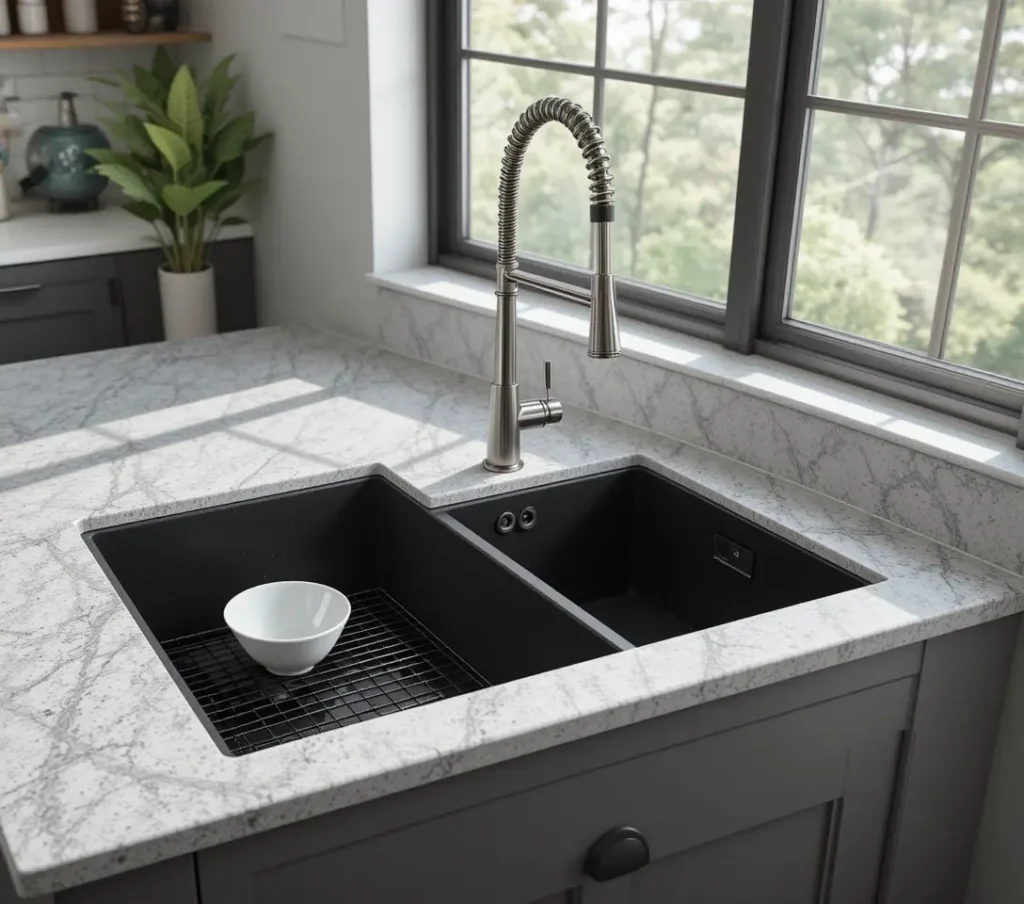
Undermount Black Sinks
- Seamless Look: Installed beneath the countertop, creating a smooth transition.
- Easy Cleaning: Wipe crumbs directly into the sink without a rim blocking the way.
- Best For: Solid-surface countertops (quartz, granite) that support the sink’s weight.
Topmount Black Sinks
- Simple Installation: Drops into a pre-cut countertop hole, secured by a visible rim.
- Flexibility: Works with laminate counters, which can’t handle undermount styles.
- Drawback: The rim can trap grease or food debris over time.
Quick Tip: Choose undermount for a modern, streamlined look. Opt for topmount if you’re on a budget or have laminate counters.
Farmhouse (Apron Front) Black Sinks
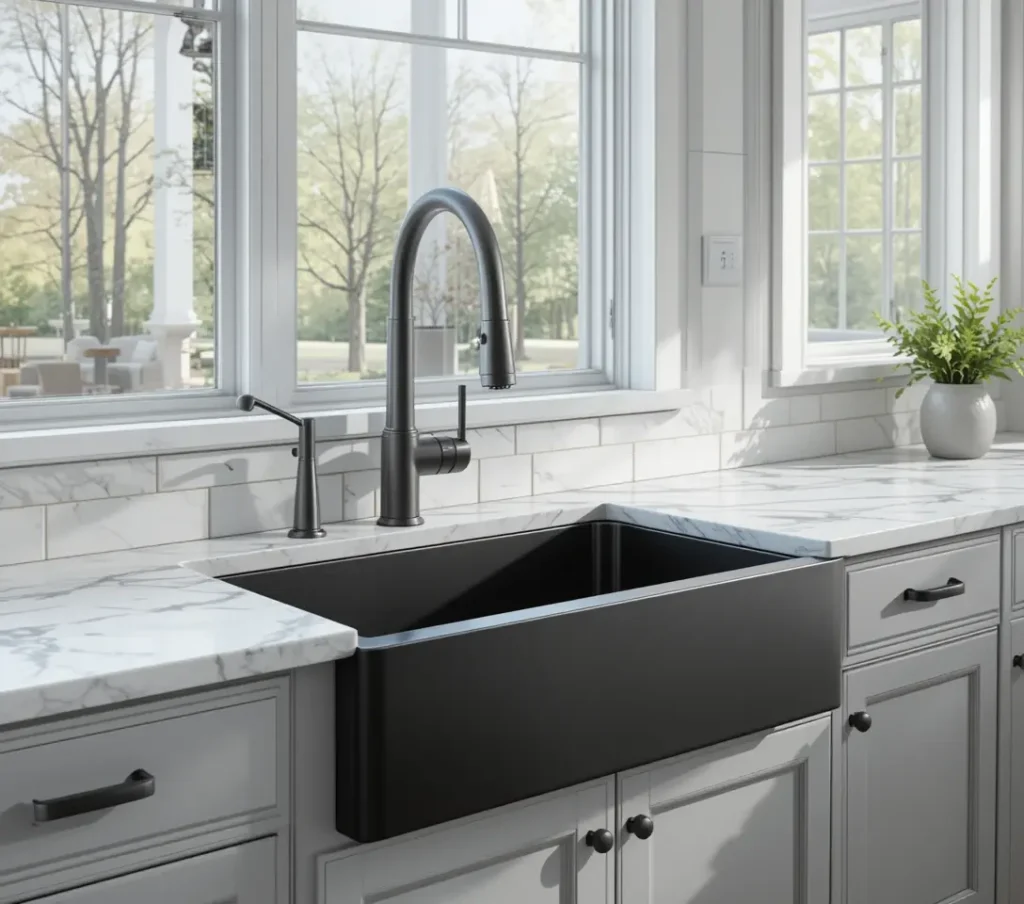
- Design: Features an exposed front panel that extends beyond the cabinetry.
- Style Fit: Perfect for modern farmhouse, rustic, or transitional kitchens.
- Considerations: Requires custom cabinetry to accommodate the sink’s front-facing design.
Why It Shines: It acts as a focal point, adding charm to open shelving or shaker-style cabinets.
Single Bowl vs. Double Bowl
Single Bowl Black Sinks

- Pros: Fits large pots, baking sheets, or party platters with ease.
- Ideal for: Home cooks who need space for soaking or prepping.
Double Bowl Black Sinks
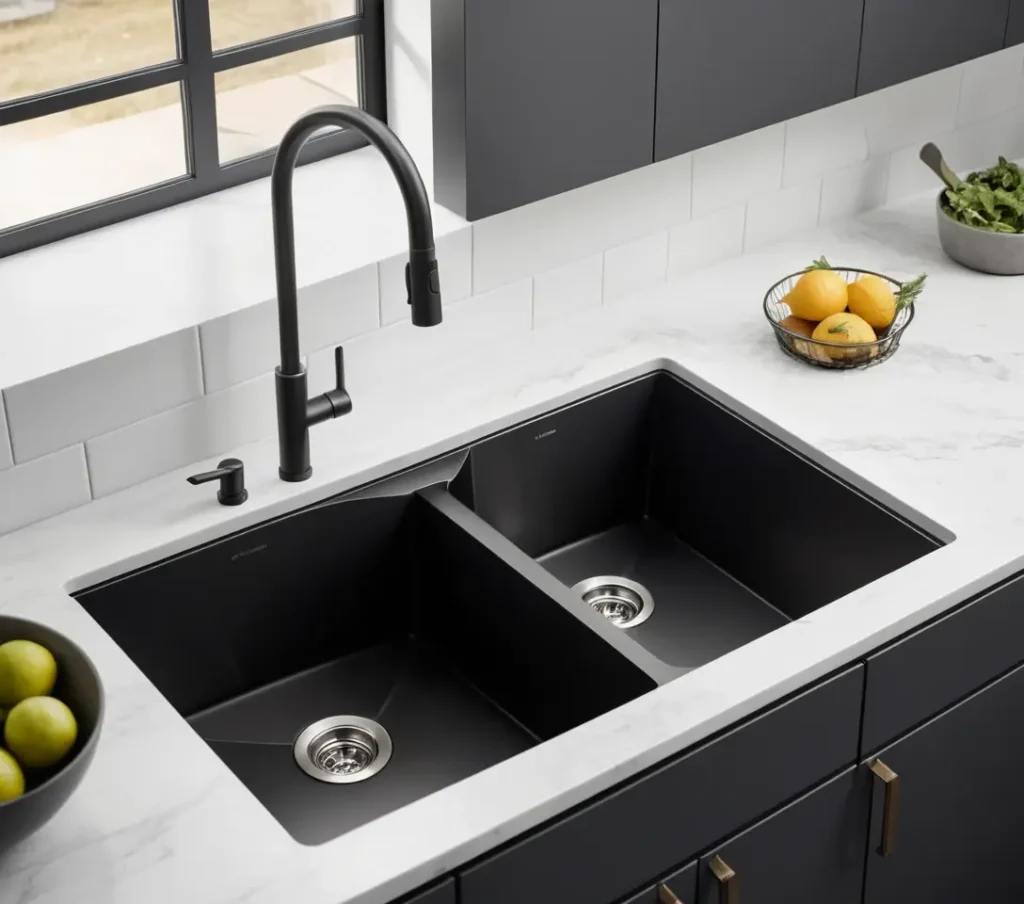
- Pros: Lets you multitask (e.g., wash dishes in one side, rinse veggies in the other).
- Options: Choose equal-sized bowls or an offset design (one large, one small).
Quick Tip: Single bowls suit small kitchens by maximizing space. Double bowls excel for frequent meal preppers.
Workstation Sinks
- Features: Built-in ledges or grooves for accessories like cutting boards, colanders, or drying racks.
- Popularity: Rising in modern kitchens for their multitasking efficiency.
- Black Finish: Adds a sleek touch while hiding scratches from daily use.
Why Choose It: Eliminate countertop clutter by integrating tools directly into the sink area.
Configuration Cheat Sheet
| Type | Best For | Considerations |
|---|---|---|
| Undermount | Modern, seamless kitchens | Requires sturdy countertops |
| Farmhouse | Rustic or transitional styles | Needs custom cabinetry |
| Single Bowl | Spacious meal prep | Limited multitasking |
| Workstation | Efficient, organized cooks | Higher upfront cost |
The Honest Truth: Pros and Cons of the Black Kitchen Sink
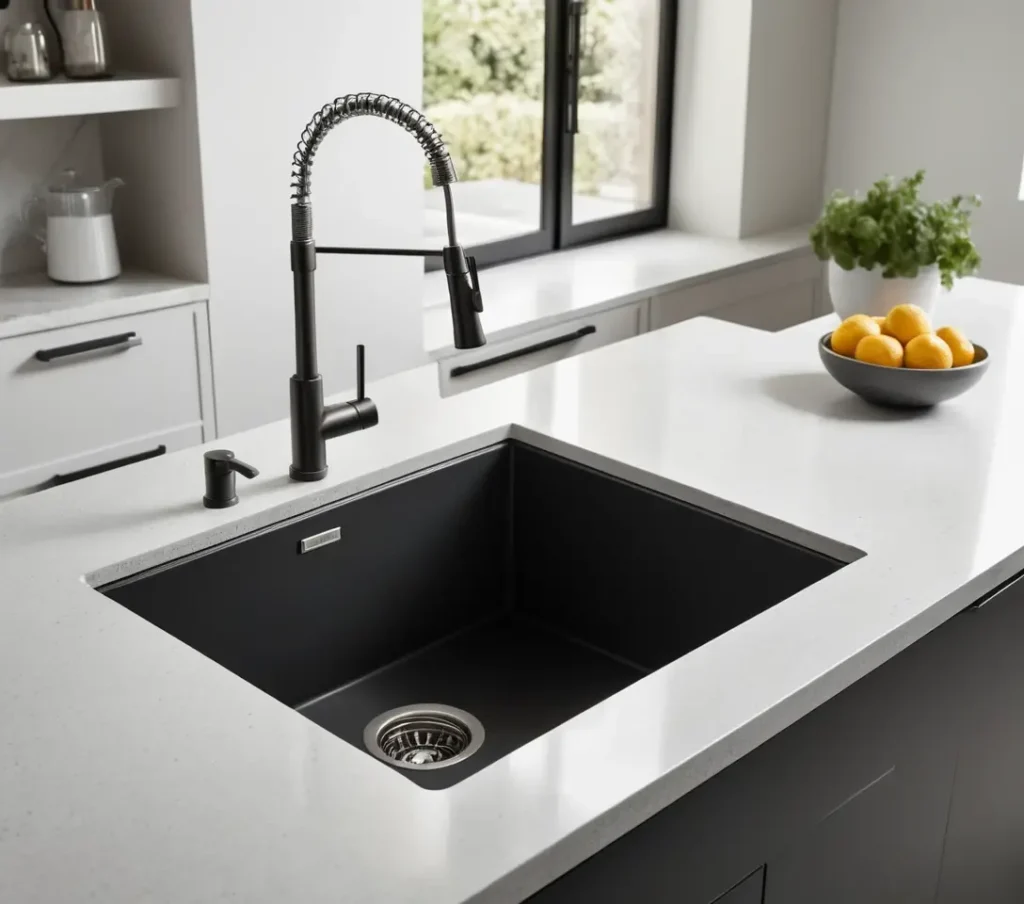
Black kitchen sinks make a bold statement, but like any design choice, they come with trade-offs. Let’s break down the advantages and challenges to help you decide if this sink is right for your home.
The Pros: Why Black Sinks Shine
- Stylish and Modern: A black sink instantly elevates your kitchen’s aesthetic, pairing well with light countertops, brass fixtures, or colorful cabinetry.
- Hides Certain Stains: Coffee spills, pasta sauce splatters, and light grease marks blend into the dark surface better than they would on white sinks.
- Durable Materials: Options like granite composite resist scratches, heat, and stains better than traditional stainless steel.
- Timeless Contrast: It creates visual depth in both minimalist and maximalist kitchens, acting as a grounding element.
The Cons: Challenges to Consider
1. Water Spots & Mineral Buildup
- The Issue: Hard water leaves white streaks or chalky deposits, which stand out sharply on black surfaces. Matte finishes mask these slightly better than glossy ones, but no finish is immune.
- The Fix: Wipe the sink dry after each use. For stubborn buildup, use a 1:1 vinegar-water solution weekly.
2. Scratch Visibility
- The Issue: While composite sinks resist scratches, coated stainless steel or enamel surfaces can show marks over time. Dark colors make even minor scratches more noticeable.
- The Fix: Avoid abrasive scrubbers. For stainless steel, use a non-scratch sponge and mild detergent.
3. Fading Over Time
- The Issue: Older composite sinks could fade under direct sunlight, but most modern options include UV-resistant coatings. Fireclay and cast iron retain color better.
- The Fix: If your sink is near a window, opt for UV-stable materials like quartz composite.
4. Cleaning Demands
- The Issue: Black sinks require regular upkeep. Soap residue, fingerprints, and dust are more visible than on lighter sinks.
- The Fix: Clean daily with a microfiber cloth and pH-neutral cleaner. Avoid bleach, which can dull the finish.
Quick Comparison: Material-Specific Challenges
| Material | Biggest Con | Easiest Fix |
|---|---|---|
| Composite | Potential fading (rare) | Choose UV-resistant brands |
| Coated Stainless | Scratching, water spots | Dry after each use, use gentle cleaners |
| Fireclay/Cast Iron | Chipping (enamel) | Dry after each use; use gentle cleaners |
Is a Black Sink Right for You?
- Yes, if: You love high-contrast design and don’t mind daily wipe-downs.
- Think twice if You prefer a “wipe-and-go” sink or have extremely hard water.
Pro Tip: Test a black sink sample in your kitchen’s lighting before buying. Shadows or bright sunlight can change how stains and scratches appear.
Keeping It Flawless: Cleaning and Maintenance Tips for Black Sinks

A black kitchen sink stays stunning with the right care. While materials like composite or coated stainless steel are durable, they need specific routines to maintain their sleek look. Here’s your step-by-step guide to keeping your sink spotless.
Daily Care: Simple Habits for Lasting Shine
- Rinse & Wipe: After each use, rinse the sink to remove food particles. Dry it with a microfiber cloth to prevent water spots—especially important in hard water areas.
- Quick Clean: For light messes, use a drop of dish soap and warm water. Scrub gently with a soft sponge.
- Pro Tip: Keep a squeegee in your kitchen to wipe down the sink quickly. It’s a game-changer for hard water zones.
Recommended Cleaners: Safe and Effective
- pH-Neutral Cleaners: Brands like Better Life All-Purpose Cleaner or Method Daily Granite Cleaner work well for composite and fireclay sinks.
- Specialty Products:
- Granite Composite: Use Bar Keepers Friend Granite & Stone Cleaner (non-abrasive).
- Black Stainless Steel: Weiman Stainless Steel Cleaner (safe for PVD coatings).
- DIY Mix: For tough stains, combine 1 part white vinegar with 1 part water. Always patch-test first!
What to Avoid: Protect Your Sink’s Finish
- Harsh Abrasives: Steel wool, gritty powders, or scrub brushes can scratch surfaces.
- Bleach & Acidic Cleaners: These can dull composite finishes or strip coatings on stainless steel.
- Letting Stains Sit: Acidic foods (tomato sauce, citrus juice) can etch surfaces if left overnight.
Real-Life Example: A reader shared that lemon slices left in their composite sink caused faint etching. Lesson learned: rinse immediately!
Tackling Stains and Buildup
Hard Water Stains
- Soak a cloth in equal parts vinegar and water.
- Lay it over the stain for 15–20 minutes.
- Wipe gently, then rinse and dry.
Note: Avoid vinegar on black stainless steel it can damage coatings.
Light Scratches
- For composite sinks: Rub a tiny amount of mineral oil into the scratch (check your manufacturer’s guidelines first).
- For stainless steel: Use a non-abrasive polish like Weiman Stainless Steel Scratch Remover.
Grease or Soap Scum
Sprinkle baking soda, add a few drops of water to form a paste, scrub gently, and rinse.
Maintenance Cheat Sheet
| Task | Frequency | Tool |
|---|---|---|
| Daily Wipe | After each use | Microfiber cloth |
| Deep Clean | Weekly | pH-neutral cleaner + sponge |
| Hard Water Treatment | Monthly (or as needed) | Vinegar solution |
Product Recommendations
| Sink Type | Best Cleaner | Price Range |
|---|---|---|
| Composite | Bar Keepers Friend Granite Cleaner | $5–$10 |
| Black Stainless | Weiman Stainless Steel Cleaner | $8–$12 |
| Fireclay/Cast Iron | Method Daily Granite Cleaner | $4–$7 |
Final Tip: Read the Manual
Always check your sink manufacturer’s guidelines. For example:
- Blanco Silgranit: Avoid abrasive pads and acidic cleaners.
- Kohler Cast Iron: Use only non-abrasive products to protect enamel.
Design Inspiration: Pairing Your Black Sink for Maximum Impact
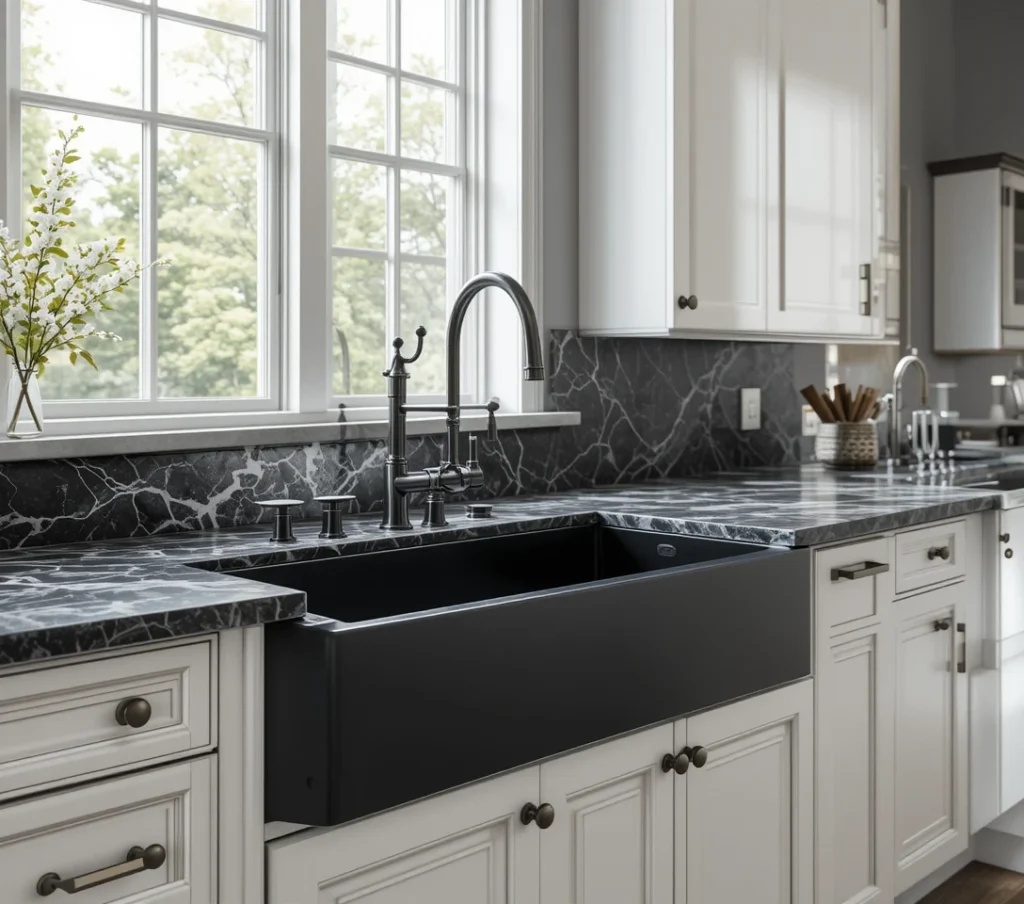
A black kitchen sink is a versatile centerpiece, but its impact depends on how you style it. From countertops to cabinet colors, here’s how to create a cohesive, eye-catching kitchen design.
Countertop Pairings
1. White Quartz or Marble
- Why It Works: Sharp contrast makes the sink pop, creating a clean, modern look.
- Bonus: Hides crumbs and smudges better than dark counters.
2. Butcher Block (Wood)
- Why It Works: Warm wood tones soften the sink’s boldness, perfect for farmhouse or Scandinavian kitchens.
- Tip: Seal the wood regularly to prevent water damage.
3. Concrete
- Why It Works: Adds raw, industrial texture. Pair with matte black faucets for an edgy vibe.
4. Dark Countertops (Monochromatic)
- Why It Works: A black sink blends with charcoal or navy counters for a sleek, moody aesthetic.
- Pro Move: Add brass hardware to prevent the space from feeling too heavy.
5. Terrazzo or Bold Patterns
- Why It Works: A patterned countertop balances the sink’s solid color, adding playful energy.
Faucet Finishes: Complement or Contrast
- Matte Black: Creates a seamless look with the sink. Ideal for minimalist or monochromatic designs.
- Brass/Gold: Adds warmth and luxury. Pairs beautifully with white counters or navy cabinets.
- Stainless Steel/Chrome: Timeless and practical. Works with any style, from traditional to industrial.
- Brushed Nickel: Subtle sheen that bridges modern and classic aesthetics.
Rule of Thumb: Match the faucet finish to other hardware (cabinet pulls, lighting) for cohesion.
Cabinetry & Backsplash Ideas
Cabinet Colors
- White or Light Gray: Lets the black sink shine as the focal point.
- Navy or Forest Green: Rich jewel tones create depth and sophistication.
- Two-Tone: Pair white upper cabinets with dark lowers for balanced contrast.
Backsplash Styles
- Subway Tile: Classic white tiles keep the look crisp. For drama, try black grout.
- Mosaic Patterns: Introduce color with emerald green or terracotta tiles.
- Stainless Steel: Enhances industrial kitchens and reflects light.
Real-Life Example: A reader paired their black sink with sage-green cabinets and a marble backsplash, resulting in a serene, nature-inspired kitchen.
Lighting & Accessories
- Pendant Lights: Choose brass or black fixtures to echo the sink’s finish.
- Open Shelving: Display white dishes or copper pots to add texture without clutter.
- Plants: Greenery softens the sink’s boldness and adds freshness.
Cheat Sheet: Top Pairings
| Style | Countertop | Faucet Finish | Cabinet Color |
|---|---|---|---|
| Modern Minimalist | White Quartz | Matte Black | White |
| Industrial | Concrete | Brushed Nickel | Charcoal Gray |
| Farmhouse | Butcher Block | Brass | Navy Blue |
| Luxury | Marble | Gold | Soft Gray |
Final Tips
- Sample Swatches: Test countertop and cabinet colors under your kitchen’s lighting.
- Mix Textures: Pair a glossy sink with a matte countertop to avoid a flat look.
- Reflect Your Lifestyle: Busy household? Opt for durable quartz and fingerprint-resistant faucets.
Choosing the Right Black Sink: A Mini Buying Guide
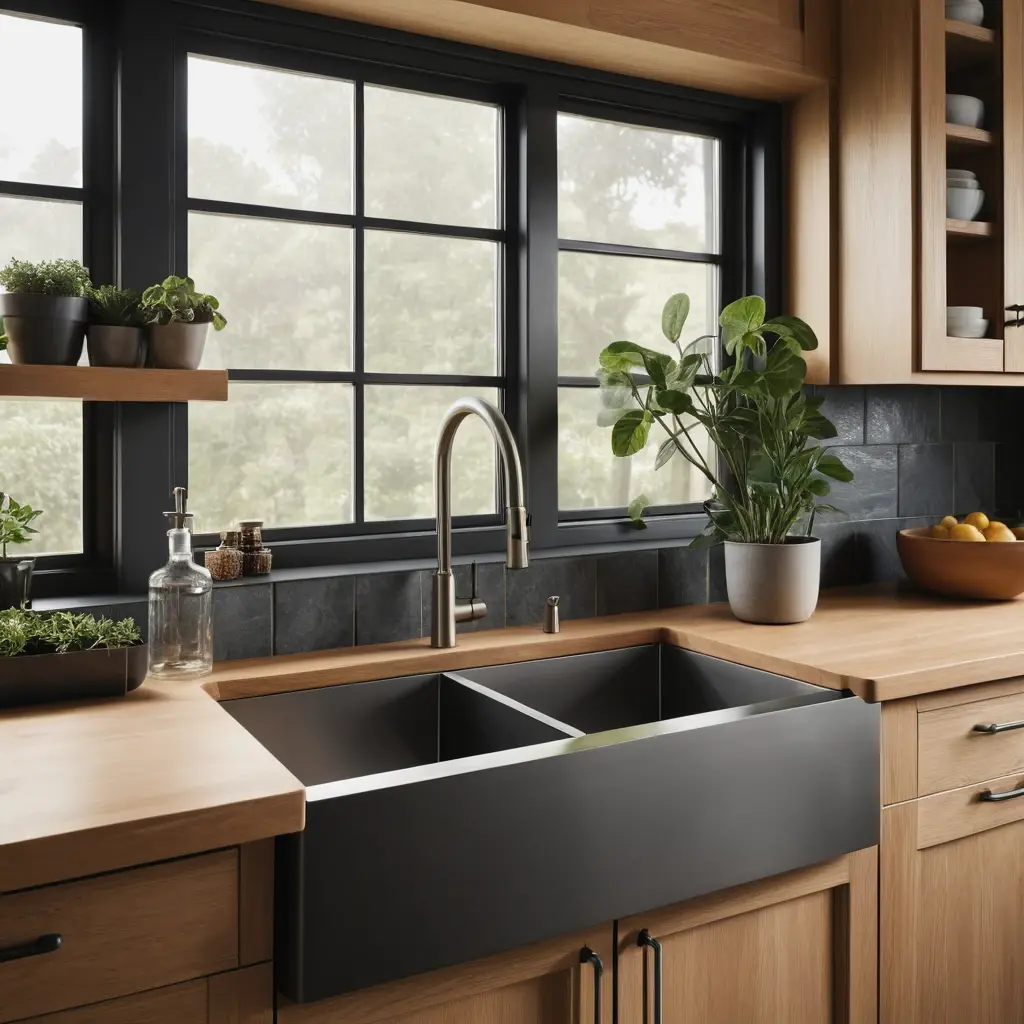
Picking the perfect black kitchen sink involves more than just aesthetics. Let’s simplify your decision with practical tips tailored to your needs.
1. Consider Your Lifestyle
- Frequent Cooks: Opt for durable materials like granite composite or fireclay. They resist scratches from pots and pans.
- Busy Households: Choose coated stainless steel for easy cleaning, but avoid if you dislike daily wipe-downs.
- Hard Water Areas: Matte finishes hide mineral spots better than glossy ones. Composite sinks handle vinegar cleaning well.
Quick Tip: If you’re accident-prone, avoid enamel sinks—chips are harder to repair.
2. Material Matters Most
Revisit Section 3 for details, but here’s a quick recap:
| Material | Best For | Think Twice If |
|---|---|---|
| Composite | Durability, low maintenance | You want a glossy finish |
| Coated Stainless | Modern, matching appliances | You dislike visible water spots |
| Fireclay/Cast Iron | Timeless, high-end appeal | Budget is tight |
3. Set a Realistic Budget
- Budget-Friendly ($300–$500): Kraus composite sinks or IKEA’s stainless steel options.
- Mid-Range ($500–$900): Blanco Silgranit (composite) or Kohler cast iron.
- Premium ($1,000+): Rohl fireclay or custom workstation sinks.
Note: Installation costs $200–$500 extra for undermount or farmhouse styles.
4. Measure Twice, Buy Once
- Standard Sizes: 30–33 inches for single-bowl; 22–24 inches per bowl in doubles.
- Cabinet Fit: Your sink should occupy ≤60% of cabinet width. Example: A 36-inch cabinet fits a 33-inch sink.
- Configuration: Single bowls suit small kitchens; double bowls aid multitasking.
Pro Tip: Print a sink template (many brands offer these online) to visualize the size in your space.
5. Trustworthy Brands & Reviews
- Blanco: Known for scratch-resistant composite sinks (Silgranit series).
- Kohler: Offers stylish cast iron and fireclay options with strong warranties.
- Kraus: Budget-friendly composite and stainless steel sinks with modern designs.
What to Check in Reviews:
- Long-term color retention (especially for composites).
- Customer service responsiveness for warranty claims.
- Noise levels (stainless steel can be louder).
Checklist Before You Buy
- [ ] Measured cabinet dimensions.
- [ ] Confirmed countertop compatibility (undermount vs. topmount).
- [ ] Read 10+ reviews mentioning “durability” or “cleaning.”
- [ ] Compared warranty terms (composite often has 10+ years).
Final Word
A black sink is an investment. Take your time visiting showrooms, test samples with your countertop materials, and prioritize ease of cleaning. Remember, the right sink should fit your habits, not just your style.
Installation Notes: Setting Up Your Black Kitchen Sink for Success
Installing a black kitchen sink requires careful planning to ensure it functions well and maintains its sleek look. Let’s break down key considerations from DIY options to drain compatibility.
DIY vs. Professional Installation
DIY-Friendly Options:
- Topmount (Drop-In) Sinks: These are simpler to install. Cut a hole in the countertop, drop the sink in, and secure it with clips. Ideal for laminate counters.
- Lightweight Materials: Composite sinks are easier to handle than heavy cast iron.
When to Hire a Pro:
- Undermount Sinks require precise cutting and mounting beneath solid-surface countertops (e.g., quartz, granite).
- Heavy Materials: Fireclay or cast iron sinks often need extra support and professional tools.
- Complex Configurations: Workstation sinks with built-in accessories may require custom plumbing.
Risk Alert: Improper installation can void warranties or cause leaks. If you’re unsure, hire a licensed plumber.
Undermount Sink Support: Non-Negotiable
Undermount sinks rely on strong support to prevent sagging or detachment. Here’s how to get it right:
- Metal Brackets: Most undermount sinks need stainless steel brackets screwed into the cabinet walls.
- Construction Adhesive: Use a high-strength adhesive (e.g., silicone caulk) to bond the sink to the countertop.
- Reinforcement: For heavy sinks, add wooden braces beneath the countertop.
What Happens If You Skip This: The sink may loosen over time, leading to water damage or costly repairs.
Drain Compatibility: Match the Aesthetic
A black sink looks best with a matching drain assembly. Here’s what to know:
- Black Drains: Brands like Kraus or Blanco offer drains in matte or glossy black finishes.
- Flange Choices: Opt for a black stainless steel or composite flange to keep the look cohesive.
- Size Matters: Ensure the drain fits your sink’s pre-drilled holes (standard sizes: 3.5″ or 4″).
Pro Tip: Buy the drain and sink together to avoid color mismatches.
Quick Installation Checklist
- Measure twice: Confirm sink dimensions fit your cabinet and countertop.
- Gather Tools: You’ll need a jigsaw (for cutting countertops), silicone caulk, and a drill.
- Test Fit: Place the sink in the cabinet before securing it to spot alignment issues.
- Seal Edges: Apply waterproof caulk around the sink rim to prevent leaks.
Final Tips
- Check Local Codes: Some areas require professional installation for plumbing work.
- Protect Your Investment: Follow the manufacturer’s guidelines to keep warranties valid.
- Ask for Help: Even confident DIYers should have a helper for heavy lifting.
By prioritizing proper support and matching components, your black sink will stay secure and stylish for years.
Conclusion: Is a Black Kitchen Sink Right for You?
A black kitchen sink is more than a trend; it’s a bold design choice that can redefine your kitchen’s personality. But like any investment, it thrives when matched to your lifestyle and maintained with care. Let’s recap the essentials:
Key Takeaways
- Material Matters: Composite sinks balance durability and affordability, while fireclay offers timeless appeal. Coated stainless steel suits modern kitchens but needs frequent upkeep.
- Maintenance Isn’t Optional: Daily wiping and pH-neutral cleaners keep water spots and scratches at bay.
- Design Versatility: From industrial concrete counters to warm butcher block, black sinks adapt to almost any style.
Why It’s Worth Considering
A well-chosen black sink elevates your kitchen from functional to striking. It pairs with trending finishes (think brass faucets or marble backsplashes) and adds resale value by signaling a modern, intentional design.
Ready to Take the Plunge?
- Test Before You Commit: Order a sample or visit a showroom to see how the sink looks in your lighting.
- Share Your Story: Already own a black sink? Tell us in the comments: What’s your best maintenance hack or design tip?
- Need Help? Drop a question below. We’re here to help!
Final Word: Whether you’re renovating or refreshing, a black kitchen sink offers a mix of drama and practicality. Choose wisely, care for it consistently, and it’ll reward you with years of sleek, sophisticated service.
Frequently Asked Questions
Are black kitchen sinks hard to keep clean?
Black sinks need regular wiping to prevent water spots, especially in homes with hard water. Matte finishes hide spots better than glossy ones. Materials like composite granite require less effort than coated stainless steel, which shows fingerprints.
Do black sinks scratch easily?
It depends on the material:
Composite sinks (granite/quartz): Highly scratch-resistant.
Coated stainless steel: Prone to scratches that expose the silver layer.
Fireclay/cast iron: Durable, but enamel can chip.
Tip: Use soft sponges and avoid abrasive cleaners.
What is the most durable black sink material?
High-quality granite or quartz composite (e.g., Blanco Silgranit) offers the best balance. These resist scratches, stains, and heat, making them ideal for busy kitchens.
What countertops go best with a black sink?
High contrast: White quartz, marble.
Warm tones: Butcher block, terrazzo.
Modern edge: Concrete, stainless steel.
Black sinks adapt to most styles, from farmhouse to industrial.
Do black sinks fade?
Quality composite sinks with UV-resistant coatings rarely fade. However, prolonged direct sunlight (e.g., under a window) might cause slight fading in cheaper models over 5–10 years.

0 thoughts on “Black Kitchen Sink The Ultimate Guide to know everything ”